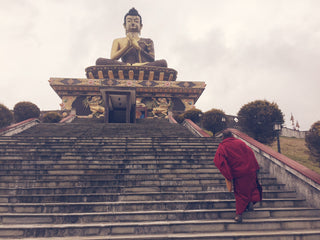
Each time I come to India, I like to visit some place I've never been before (and after five years and some ten trips, there is still so much undiscovered). This trip, that unknown destination was Sikkim. Since Tibetan Socks is funding the Sikkim Lunch program, where each pair of socks provides 12 school lunches to children from extremely impoverished families at Lama Paljor's school in Phadamchen, I was eager to meet the Lama who had started this altruistic project some ten years ago.
Situated in the North East of the country, bordering the Tibet Autonomous Region of China to the North, Bhutan to the East and West Bengal to the South, it is a tiny jewel of a state encompassing diverse breathtaking landscapes.
Visiting Sikkim requires a special permit, which can be had easily and free of charge either at the border checkpoint or within Delhi at the Sikkim embassy. The closest airport is Bagdogra, in West Bengal. During the winter months when the weather is often foggy, arriving and leaving from this airport can post significant problems - on my return, I was stranded for two days, unable to leave with all flights cancelled due to fog at this little airport which cannot operate under sub-par conditions. From Bagdogra, you can either charter a helicopter to the state capital of Gangtok, a ride lasting 30 minutes, or take the long four-five hour drive through increasingly winding and vertiginous mountain roads.
After arriving in Bagdogra in the late afternoon, a taxi brought me to Kalimpong, a small hill town just before the Sikkim border where Lama Paljor sometimes stays as the senior abbott. It was an immense privilege and life experience to stay in the monastery with the Tibetan Buddhist monks, most of whom where under twenty years of age as the senior monks were attending the Dalai Lama's discourse in Karnataka state to the South.
I awoke the next morning at 6:30 to attend the morning prayer ritual held in the temple. I meditated in silence as the monks chanted in Tibetan for an hour and a half. There was a brief silent intermission where the monks sipped tea before finishing their chants.

After breakfast, Lama Paljor and I drove the two hours into Sikkim. Our first stop was a visit to the Buddha Park of Ravangla in South Sikkim. This 130-foot gold Buddha statue was consecrated in 2013 by the Dalai Lama to mark the 2,550 birth anniversary of Gautama the Buddha. Inside the statue is an incredible mural depicting the Buddha's life from infancy to death.

Just driving around Sikkim was an adventure itself: the roads are incredibly narrow, allowing for only one car to pass at a time with steep mountain ledges. A journey of thirty kilometres can easily take hours as one might be stopped for forty minutes while a road is paved, blocking traffic from both directions. It is on these difficult roads that the parents (often mother and father) of the students at Lama Paljor's school labor - for around $100 a month. There is little other work available in the high mountain region of East Sikkim where the Tsel English Academy is located. The weather is freezing, with snow coating the mountain tops nearly year-round.
We begun the next day in Gangtok, the Sikkimese capital located in the Eastern province. A bustling hill city, the roads are not unlike San Francisco with steep inclines, twists and turns and of course difficult traffic!

I had greatly desired to visit Tsomgo Lake further East, however a separate permit was required for another checkpoint - and foreigners must be in groups of two with a tour guide. Tsomgo Lake not only boasts incredible snow capped mountain views, but also has yak rides! Alas, this is high on my list for my next visit to Sikkim.
Deterred by this restriction, we instead headed for nearer wilderness - which Sikkim has in abundance. Lovers of eco-tourism can spend a week or more visiting the various nature preserves, trekking paths and camping areas. I spent the afternoon hiking in the Nampong-Lingdock zone with a local tour guide, taking in the incredible silence and isolation of the mountain peak.
It was a total of three days spent in Sikkim, not nearly enough time to revel in all the sights and adventures. Since I was a solitary foreigner, there were many places off limits to me and next time pre-planning and a travel partner will yield many more opportunities for exploration.

I am grateful to Lama Paljor for his humbling hospitality in not only welcoming me into the Kalimpong Monastery, but also being my guide around Sikkim. Getting to sit with him and hear about his life, being the child of Tibetan refugees, becoming a monk at age thirteen, and his work with the Tsel English Academy which he started ten years ago as self-less service to the poorest residents of sparsely populated East Sikkim - work which now provides a primary English education to over a hundred students a year - giving them free food, clothing, and shelter as well as a foundation to build a better life.






